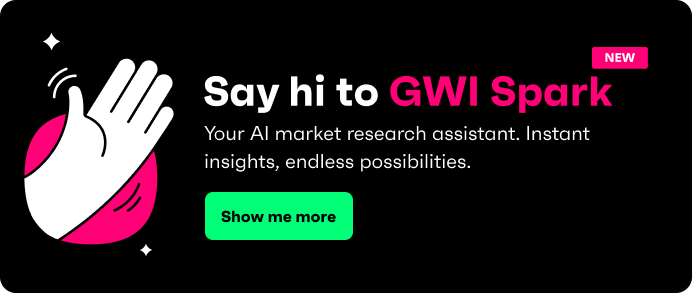Social media never sits still - and 2025 is proving that in a big way.
From who’s online to how they’re interacting with content, brands, and each other, the landscape is shifting fast. We’ve crunched the latest GWI data and broken it down into the stuff that actually matters - so you can keep up, plan smart, and stay ahead.
Let’s get into it.
What are the most popular social media platforms?
The usual suspects are still going strong - Facebook, Instagram, YouTube, TikTok, X, and Pinterest remain the top platforms used by consumers outside of China.
But there’s a new(ish) kid making serious waves: Threads. When Threads launched in summer 2023, plenty of people wondered whether the hype would last. Now? It’s the fastest-growing social platform across all generations. To put that into perspective, the share of people logging in daily is on par with the number who work in the IT sector.
So what's driving the buzz? Threads taps into what users want most right now: timely news and meaningful communities - two motivations that are powering the rise of conversation-driven apps. And it’s not just Threads riding the wave - Reddit, X, and Telegram Messenger are all seeing sharp year-on-year growth too. With 2024 being packed with global elections and heightened political tension it’s no wonder users flocked to platforms built for discussion, debate, and idea-sharing.
What are people actually using social media for?
The days of mindless scrolling are (mostly) behind us. A growing number of people are turning to social platforms to stay informed, with news consumption now one of the top reasons for logging on.
Since Q4 2021, there’s been a 58% increase in the number using TikTok to keep up with the news, and a 30% rise in Snapchat users doing the same. What’s interesting is that these video-first apps - once seen purely as entertainment spaces - are now becoming key sources for current events.
And it’s not just about keeping up with the news - there’s also been a major uptick in messaging and connecting. Since Q4 2021, there’s been a 58% increase in the number using TikTok to message friends and family, a 23% rise on Snapchat, and a 23% jump on Instagram. Looks like social’s becoming more social again. Go figure.
Short form video is still king
Video continues to dominate social - and it’s popping up in places you might not expect. Take LinkedIn. Once known strictly for job hunting, it’s now a surprisingly active video hub; over a quarter of users watched a video there in the past month. That’s more than the number who messaged a recruiter or employer.
And it’s not just LinkedIn that’s evolving. Platforms built for video are leaning in even harder. Instagram Reels engagement is up 25% since Q4 2021, and the platform has expanded the max length to 3 minutes for users who want longer content. Meanwhile, YouTube Shorts are thriving, with over half of YouTubers engaging in the past month, and TikTok - the original short-form darling - has blown past its 60 second roots. You can now record 10 minute videos, or even upload content up to an hour long.
The takeaway? Short form video might still rule, but the ideal length is however long it takes to tell a story that keeps people hooked.
Generational shifts in social media habits
Generational differences in social media aren’t so much about what platforms people use as how they use them.
- Gen Z’s top platforms are YouTube, Instagram, Facebook, TikTok, and X.
- Millennials follow a similar pattern, with Facebook, Instagram, YouTube, TikTok, and X.
- For Gen X and baby boomers, Facebook and YouTube lead the way, with Instagram, TikTok, and X close behind.
We might all be on the same apps, but how we use them - and why - can look pretty different. Gen Z are all about video-first platforms, with YouTube and TikTok dominating their screens. They’re also (unsurprisingly) leading the charge on Snapchat.
Baby boomers, on the other hand, stand out for their love of Nextdoor, where local updates and community conversations take the spotlight. And millennials? They’ve taken to Threads more than most - possibly because they’re already comfortable navigating Meta’s world. This early adoption has helped Threads build that serious momentum we touched on earlier.
Social media and mental health: It’s complicated
Younger people are the heaviest users of social media, but also the most likely to say it’s harming their mental health. It’s a paradox that speaks volumes about how complex our relationship with social platforms has become.
But it isn’t just about how much time they spend online. For 16-34 year olds, how they engage matters much more than how long they scroll for. Those who use social platforms to share opinions, discover new ideas, and connect with fresh faces are far more likely to see it as a force for good. Meanwhile, those who stick to passive browsing and their familiar circles tend to feel the weight more heavily.
For brands, there’s a real window of opportunity. The more you can encourage participation - rather than just pushing content - the more you can turn passive lurkers into active users, building more positive, meaningful connections.
Social media and brand discovery
Long gone are the days when social media was just about staying in touch with friends - it’s now become a major part of the path to purchase. It’s where people go to discover new brands, get inspired, and dig into products they might want to buy.
And the numbers prove it. Since Q4 2021, there’s been a 71% increase in people using TikTok to follow or find information about brands and products. On Snapchat, that figure is up 31%.
The shift? It’s not just about ads in the feed. Today’s users want content that feels relevant, timely, and useful - something that speaks to what they care about in the moment. For brands, that means showing up with more than a sales pitch. It’s about creating content that informs, entertains, and fits naturally into the scroll.
Livestreaming is booming - especially in APAC
Long before TikTok jumped on the bandwagon, livestreaming was already a cultural force in APAC. From mukbangs to live shopping events, the region set the standard for what interactive, real-time video could look like - turning viewers into participants and content into commerce.
Now, that influence is spreading - livestreaming is gaining serious traction in the West, too. Platforms like Twitch laid the groundwork, and today, nearly 2 in 5 US TikTokers have watched a livestream in the past month - putting the US ahead of the global average.
There’s a big takeaway here for Western brands: authenticity matters. In APAC, two-thirds of livestream shoppers say they prefer events hosted by everyday people rather than influencers or celebrities. That shift toward relatable, real voices could be the key to unlocking livestream commerce at a global scale.
How much impact do influencers really have?
Influencers have steadily climbed the ranks in who we follow. Back in Q4 2020, they sat at 9th place. By the end of 2024, they’d jumped to 6th. So what’s driving that shift?
A big part of the answer is vlogs. Of all the media formats we track, vlog content stands out as one of the most trusted when it comes to product research. Half of vlog watchers say they trust what they see in those reviews. Why? It comes down to transparency. Vloggers show the full journey, from unboxing to final thoughts, creating the kind of social proof that feels honest, relatable, and real.
Relevance and needs-based marketing also play major roles. 41% of influencer followers say they looked into a product after seeing it on social because it aligned with something they actually needed - compared to just 30% of the average consumer. When content feels timely and personal, it lands harder.
Of course, not all platforms play by the same rules. On Reddit, followers tend to gravitate toward gaming and fitness experts. On Facebook, it’s key figures like politicians or even royalty. Knowing who your audience pays attention to - and why - can help brands show up in the right way, in the right place, at the right time.
Social’s role in US politics
Social media played a powerful role in the 2024 US election - not just as a source of news, but as a space where alternative voices and opinions could break through.
As trust in traditional media continues to decline, especially among conservatives, many voters are looking for spaces where they feel their views aren’t being filtered or dismissed. In fact, half of Republican voters say they wish news outlets were less biased, with many believing certain perspectives are being filtered out.
That search for unfiltered voices opened the door for certain content formats like podcasts, which played an unexpectedly influential role during the election. Their long-form, unedited format gave space for raw, candid takes - something voters increasingly craved in a highly polarized environment.
And it’s not just podcasts. Apps like Telegram Messenger are gaining traction for similar reasons. Positioned as censorship-free zones, they appeal to users who are actively seeking out content beyond the mainstream narrative.
Bottom line? For political discourse in the US, social media isn’t just a side channel anymore - it’s a core part of how people seek truth, challenge narratives, and find their community.
What content works best on each channel?
When it comes to content, every platform has its own sweet spot. Each audience has its own expectations, tone, and sense of what feels relevant. Here’s the cheat sheet:
- On Facebook, people respond to brands that come across as smart, exclusive, and trendy.
- Instagram users want that same exclusivity - with a trend-led edge.
- TikTok audiences skew younger and value content that’s funny, relatable, and in the moment.
- Snapchat users favor bold, playful content that doesn’t take itself too seriously.
- On X, it’s about exclusivity and edge - bold, on-trend, and opinionated.
- Reddit rewards authenticity above all, along with smart, no-frills delivery.
- And on LinkedIn, the bar is high: content needs to be bold, smart, and worthy of professional attention.
For brands, this isn’t about completely changing your identity - it’s about matching your message to the room you’re in.
AI and social media
It’s no secret that AI is already transforming how brands show up on social media. According to marketers, two of the top ways companies are using it right now are for content creation and customer service - both of which have a direct impact on how brands engage with audiences.
But while brands are leaning in, users are a bit more selective. Interest in AI-generated content depends heavily on what it is. There’s real curiosity around AI-generated music (60%) and comedy videos (57%), but enthusiasm drops when it comes to more branded content - like ads (34%) and podcasts (35%).
And not all platforms are equally welcoming. Users on BeReal, Reddit, and X tend to be more skeptical of AI content. In contrast, TikTok has shown it’s more open to experimentation - as seen with Maybelline’s viral CGI mascara video, which sparked genuine interest and engagement.
The key takeaway? AI can work on social - but only when it fits the platform and feels relevant to the audience. It's a creative tool, not a one-size-fits-all solution.
Final thoughts
These stats don’t just tell us what’s happening on social - they show us how people are feeling, thinking, and interacting in real time. From Gen Z's love of video to livestreaming’s global rise and AI’s cautious entry into the mix, it’s clear that connection, relevance, and authenticity matter more than ever. The brands that lean into that? They’re the ones that will stand out.






.webp?width=495&height=317&name=pink_thumb_graphs%20(1).webp)
.webp?width=495&height=317&name=pink_thumb_letter%20(2).webp)
